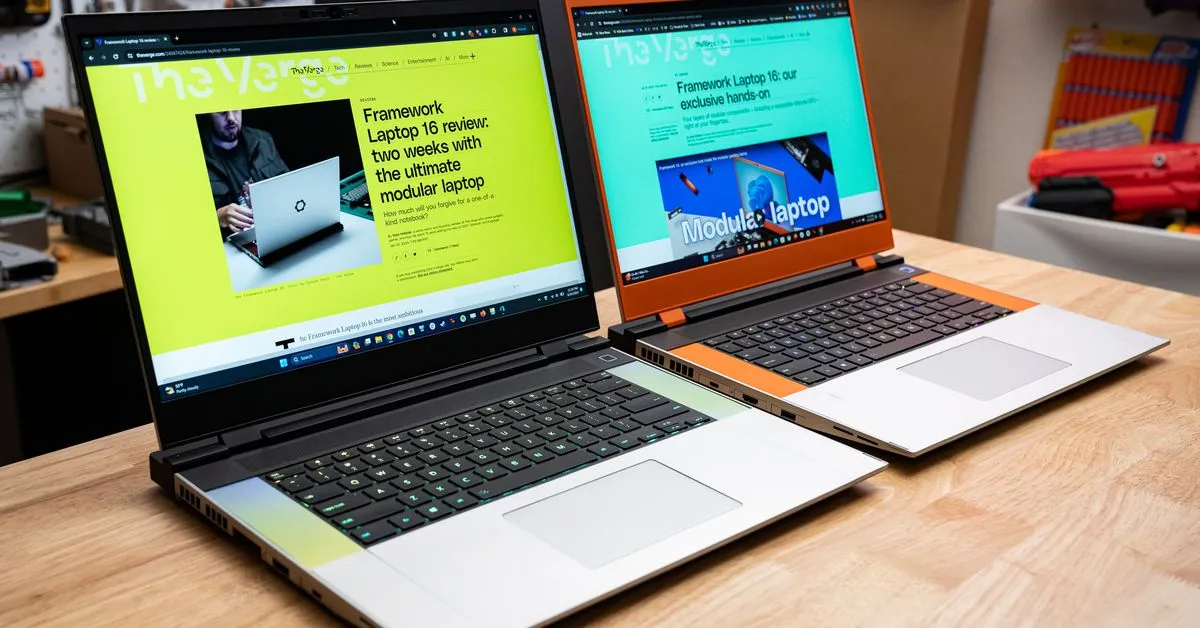Six months later, with a new unit and new firmware, I’m feeling a bit better! Not good enough to give it my full recommendation, but enough to raise its score to 6 out of 10, which we define as: “Good. There are issues but also redeeming qualities.” But while the laptop’s more stable, most of my other annoyances are still kicking.
Dang, that lid flex sure is something.
This is the best summary I could come up with:
You can transform it from a sleek work laptop to a decent gaming machine in two minutes flat, one which charges with the world’s first 180W USB-C power adapter.
The product gave me multiple Blue Screens of Death, glitched, felt flimsy in places, and ran hotter and louder than its performance would suggest.
I’m happy to say I’ve only seen the computer fail once during that entire month — an “It looks like Windows didn’t load correctly” error I haven’t been able to reproduce.
We even figured out my mystery issue where the excellent 2560 x 1600 screen would suddenly seem to wash out — that’s due to AMD’s Vari-Bright setting, which attempts to save battery when the integrated GPU is in command.
Despite this replacement coming with a slightly weaker 7840HS, I’ve measured 100.8°C at peak while playing a game — and as high as 92.5°C one day when I was just writing a story in a web browser.
After a month, I’ve decided I could live with the lid flex and the uneven surfaces created by Framework’s modular spacers and touchpad.
The original article contains 931 words, the summary contains 183 words. Saved 80%. I’m a bot and I’m open source!
It’s v1 from a relatively new company, trying something unprecedented. I’m not surprised it has some major flaws. The first Gen framework 13 did as well.
I own a Gen2 and a Gen3 framework 13 and they are both phenomenal. I would recommend them to anyone looking for a slim laptop, that wasn’t overly concerned about cost.
I’m sure the Gen3 FW16s will be great as well, but it’s going to be a bit before I would recommend them to anyone.
What I think would be great for framework to do next is to design a purpose built eGPU for the framework 13. I would really enjoy something that would turn the FW13 into a decent gaming PC, while still retaining the portability for travel.
deleted by creator
It’s not v1 though, it’s v4 of the concept. They already made 3 generations of the concept with the framework 13, and it’s pretty bad to have these kind of issues after that many attempts.
You do realize the 13 doesn’t have the back part for replaceable dedicated GPU right? That means the chassis itself must be redesigned since the hole will make the previous experience in the 13 different enough.
But the entire concept of a modular build with replaceable ports should be well known. They should not have panel gaps, bad alignment with height differences and stability issues with these parts because they’ve had multiple design iterations of this already. So why have they seemingly not applied any of this knowledge and experience they have from the 13 to the 16? These are the same issues gen 1 of the 13 had, they should not exist on the 16 that uses the exact same design for these parts.
Uhh, does the model 13 have a modular panel? IIRC, they don’t. Also, manufacturing modular panel and modular port are very different and the knowledge transfer cannot be that big. The port for example has a looser tolerance since they aren’t really that visible most of the time. So being snug but not flush is good enough. I can imagine the panel doesn’t have that luxury. Stability issue, that I can agree. But then again, I’ll give them the benefit of the doubt since they must handle additional assumptions that cannot be made on other laptops. Namely, modular GPU. Writing a firmware with that new assumption could be a PITA.
But the 16 still has issues with the modular ports, this really shouldn’t be the case. That stuff should be ironed out by now. By the fourth generation of port modules, they absolutely should fit well, look good and work properly all the time…but they don’t
Oh really? I didn’t know that once since I only referenced the article. The article had issues with the modular top side, not the port. So I guess we were talking differently from the beginning.
The article also mentions how the ports are not seated well and also talks about how they’re unstable in the OS.
Some of these things might just be the usual Windows problens…like with the heat and fan noise. I have seen huge differences in a few machines (x86 tablet/HP laptop/thinkpad) running Linux vs running Windows. The machines running Linux hardly make a peep until you play a game or compile something. On Windows they were hot and noisy af, night and day difference.
I dual boot my Framework 13 Gen 1 and in Windows the fans ramp up within a couple of minutes of just doing some very light work. In Linux the only time the fans ramp to a noticeable level is if I “block” the exhaust when using it on a bed or couch, or a workload that goes full beans.
The random ravving when it is furiously pinging the mother ship with high read write… i am sure all of that is for your own good lol
This statement doesn’t actually give a clear picture. It’s doesn’t explain why.
It’s the windows fan curve more aggressive?
What programs were being ran?
What was the actual fan speed?
What was the actual temp?
What was the exact version of Windows/Linux?
We’re these ‘experiments’ ran in the same hardware under the same conditions.
You can choose to be LTT and just say whatever and pass it off as fact, or you can be GN and back it up with highly detailed facts.
Yea sure, you can go and do all that. Im just speaking from my personal experience. There were no experiments, it’s just the behavior I notice from Windows before the device gets the Linux treatment.
Sure it’s expensive but it’s so easy to customize and fix
Sometimes i wonder why Framework laptop is more expensive than premade laptop from reputable brand ?
I’m not saying it’s bad or anything but you can buy more powerful premade laptop for that price tho… although you don’t get interchangeable part like Framework but sure you can get more powerful laptopThe answer is there, keep wondering 🙂
Because they’re a small company producing a niche product, so the scale they produce on is way smaller too. They also don’t have a huge B2B branch to cover their other costs with, like HP, for example.
And it is actually sometimes more expensive to make something modular than not, just in manpower and testing alone, not even considering RnD and manufacturing. Also, they make less money in repairs or new devices, if the users can just easily repair the device themselves.
So unless they manage to stay in the business for a while and grow their customer base by quite a big amount, their prices will most likely stay the same. Personally I think that they’re on a good path to getting there eventually.
Existencial issues money trower
I haven’t had a single issue with crashes, noise, heat, display, etc.
The positioning/gaps of the spacers are extremely tiny, and barely noticeable, and the only issue I’ve had so far has been my laptop not turning off fully when I shut it down, but that’s fixed by just holding down the power button.
Oh, and I’m running an unsupported linux distro, (NixOS) so it’s not like I’m starting from any advantaged position in terms of software integration.
Performance is great, cooling is great, games run well and it boots up quickly. Nothing much else to say other than it’s a good laptop.






